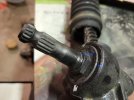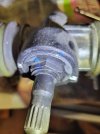Rupunzell
Bernice Loui
The pinch bolts on the steering wheel axle to steering rack pinion will not engage the nut if the splined ends are not properly fitted. The splined shafts are grooved for the M8 bolt, long as stock length bolt and prevailing torque lock nut is used, improper assembly is not possible by design.I agree with each of these points. The pinch bolt maybe if worn or forced enough might be able to be off but I remember it sliding home easily enough when I matched up the splines correctly.
The only thing I could see causing the pinion movement other than the rack itself at fault would be the rack mount bolts loose or firewall flex but I checked the bolts and certainly not enough force to flex the sheet metal.
loose steering brakes are possible, but not common at all. There is a set of bushings used between the steering rack to bracket. These seldom create problems, and the hardware involved self loosening is not common.
~Check this.
Removal of the steering rack is not that difficult, regardless do all the previously mentioned checks to completely rule out those common issues.
Proper steering on the exxe should be like a good micrometer, tight, precise, direct and about zero slop.
Bernice


